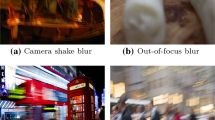Abstract
In this work we discuss methods for image ringing detection and suppression that are based on the sparse representations approach and suggest a new ringing suppression method. The ringing detection algorithm is based on construction of the synthetic dictionary that is used to represent ringing effect as a sum of blurred edge and pure ringing component. This decomposition enables us to estimate image ringing level. We analyze two ringing suppression methods. First method is based on learning joint dictionaries and shows good performance for the whole image on average. However for high ringing levels the performance of this method decreases due to the influence of the ringing artefact on the sparse representation parameters. The second method is based on separate learning of natural images dictionary and pure ringing dictionary and it does not suffer from this problem. In this article we present a new ringing suppression method that is based on the method using separate dictionaries. The method works best in the areas of edges and for higher levels of ringing effect.
Similar content being viewed by others
References
A. V. Nasonov and A. S. Krylov, “Edge quality metrics for image enhancement,” Pattern Recogn. Image Anal. 22 (2), 346–353 (2012).
C. C. Koh, S. K. Mitra, J. M. Foley, and I. E. Heynderickx, “Annoyance of individual artifacts in MPEG-2 compressed video and their relation to overall annoyance,” in Proc. Electronic Imaging Conf. (San Jose, CA, 2005), pp. 595–606.
A. Punchihewa and D. G. Bailey, “Artefacts in image and video systems; classification and mitigation,” in Proc. Image and Vision Computing (New Zealand, 2002), pp. 197–202.
H. Chang, M. K. Ng, and T. Zeng, “Reducing artifacts in jpeg decompression via a learned dictionary,” IEEE Trans. Signal Processing 62 (3), 718–728 (2014).
H. Liu, N. Klomp, and I. Heynderickx, “A perceptually relevant approach to ringing region detection,” IEEE Trans. Signal Processing 19 (6), 1414–1426 (2010).
L. Liang, S. Wang, J. Chen, S. Ma, D. Zhao, and W. Gao, “No-reference perceptual image quality metric using gradient profiles for JPEG2000,” Signal Processing: Image Commun. 25 (7), 502–516 (2010).
P. Marziliano, F. Dufaux, S. Winkler, and T. Ebrahimi, “Perceptual blur and ringing metrics: application to JPEG2000,” Signal Processing: Image Commun. 19 (2), 163–172 (2004).
A. V. Nasonov and A. S. Krylov, “Scale-space method of image ringing estimation,” in Proc. Int. Conf. on Image Processing (Cairo, 2009), pp. 2793–2796.
A. V. Nasonov and A. S. Krylov, “Adaptive image deringing,” in Proc. GraphiCon2009 (Moscow, 2009), pp. 151–154.
I. T. Sitdikov and A. S. Krylov, “Variational image deringing using varying regularization parameter,” Pattern Recogn. Image Anal. 25 (1), 96–100 (2015).
S. Mallat, A Wavelet Tour of Signal Processing: The Sparse Way (Elsevier, 2008).
M. Elad, Sparse and Redundant Representations (Springer, 2010).
M. Elad, M. A. Figueiredo, and Y. Ma, “On the role of sparse and redundant representations in image processing,” Proc. IEEE 98 (6), 972–982 (2010).
A. V. Umnov, A. V. Nasonov, A. S. Krylov, and D. Yong, “Sparse method for ringing artifact detection,” in Proc. 12th Int. Conf. on Signal Processing (Hangzhou, 2014), pp. 662–667.
A. V. Umnov and A. Krylov, “Ringing artifact suppression using sparse representation,” Lecture Notes Comput. Sci. 9386, 35–45 (2015).
A. V. Umnov and A. S. Krylov, “Research of sparse representation method for ringing suppression,” Comput. Opt. 40 (6), 895–903 (2016).
MMIP Ringing Database, (MMIP Lab., 2017). http://imaging.cs.msu.ru/en/research/ringing/database.
J. Yang, J. Wright, T. S. Huang, and Y. Ma, “Image super-resolution via sparse representation,” IEEE Trans. Image Processing 19 (11), 2861–2873 (2010).
A. Krylov and A. Umnov, “Inuence of gibbs phenomenon on the mutual coherence in sparse representations,” Moscow Univ. Comput. Math. Cybern. 40 (4), 155–160 (2016).
A. S. Krylov, A. A. Nasonova, and A. V. Nasonov, “Image enhancement by non-iterative grid warping,” Pattern Recogn. Image Anal. 26 (1), 161–164 (2016).
Z. Wang, A. C. Bovik, H. R. Sheikh, and E. P. Simoncelli, “Image quality assessment: from error visibility to structural similarity,” IEEE Trans. Image Processing 13 (4), 600–612 (2004).
Author information
Authors and Affiliations
Corresponding author
Additional information
The article is published in the original.
Alexey Vitalievich Umnov, born 1990, graduated from Faculty of Mechanics and Mathematics, Lomonosov Moscow State University (MSU) in 2012. He is currently a junior researcher at the Faculty of Computer Science, National Research University Higher School of Economics (HSE). He has 9 publications in total, and his main interests lie in area of image processing using machine learning.
Andrey Serdzhevich Krylov, born 1956, graduated from the Faculty of Computational Mathematics and Cybernetics, Lomonosov Moscow State University (MSU) in 1978. Received the PhD degree in 1983, the Dr.Sc. degree in 2009. He is a professor and the head of the Laboratory of Mathematical Methods of Image Processing at the Faculty of Computational Mathematics and Cybernetics, Lomonosov Moscow State University (MSU). He has 137 publications in total, and his main research interests lie in mathematical methods of multimedia data processing and analysis.
Rights and permissions
About this article
Cite this article
Umnov, A.V., Krylov, A.S. Sparse approach to image ringing detection and suppression. Pattern Recognit. Image Anal. 27, 754–762 (2017). https://doi.org/10.1134/S1054661817040186
Received:
Published:
Issue Date:
DOI: https://doi.org/10.1134/S1054661817040186




